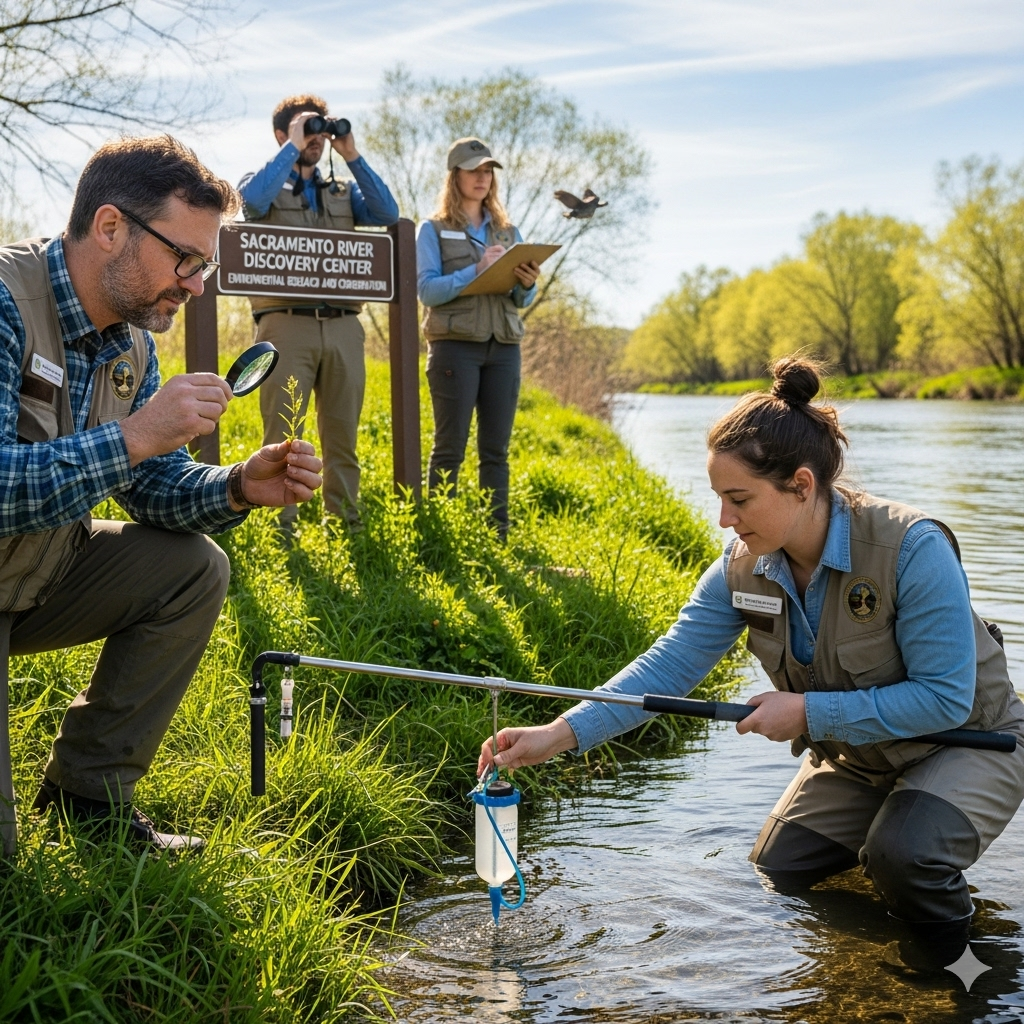Conservation & Research

Conservation & Research at Sacramento River Discovery Center | Nature & Education Center
The Sacramento River is more than a waterway—it is the lifeblood of Northern California’s ecosystems, agriculture, and communities. At the heart of its preservation is the Sacramento River Discovery Center, a place dedicated to educating the public, inspiring stewardship, and leading efforts in conservation and research. Through scientific studies, habitat restoration projects, and community partnerships, the Center plays a vital role in ensuring that the Sacramento River continues to thrive for generations to come.
A Mission of Stewardship and Sustainability
The Discovery Center’s conservation and research efforts are guided by a simple but powerful mission: to protect the natural resources of the Sacramento River while advancing public understanding of their value. This mission blends education with action, reminding us that protecting the environment is not a one-time event but an ongoing commitment.
The Center serves as both a research hub and a community classroom, bridging the gap between scientific study and everyday practices that benefit the environment.
Research on Ecosystems and Biodiversity
River Ecology Studies
One of the Center’s core areas of research focuses on the Sacramento River’s dynamic ecosystem. Scientists and educators study the river’s water quality, seasonal flow patterns, and sediment movement to better understand its role in shaping local habitats. These studies provide valuable insights into the effects of drought, flooding, and climate change.
Wildlife Monitoring
From salmon and steelhead trout to raptors and migratory birds, the Sacramento River corridor is home to an extraordinary diversity of species. The Discovery Center conducts wildlife surveys and monitoring programs, often with the help of volunteers and citizen scientists. These efforts help identify population trends, track migration patterns, and highlight species at risk.
Native Plants and Habitats
The Center also engages in research on native plant communities, examining how they contribute to soil health, water retention, and wildlife support. By studying native versus invasive species, researchers can develop strategies for restoring ecological balance.
Conservation in Action
Habitat Restoration
One of the Center’s most visible conservation efforts is habitat restoration. Staff, students, and volunteers work together to plant native vegetation along riverbanks, restore wetlands, and protect riparian corridors. These projects not only improve biodiversity but also strengthen the natural defenses of the river against erosion and pollution.
Water Quality and Resource Protection
Protecting the Sacramento River means protecting its water. The Center actively promotes water conservation practices, such as sustainable irrigation, stormwater management, and pollution prevention. Research programs often focus on how agricultural practices, urban development, and climate shifts impact water resources.
Sustainable Landscaping Demonstrations
To bring conservation into people’s daily lives, the Discovery Center maintains demonstration gardens showcasing drought-tolerant and native plants. Visitors can learn how to create eco-friendly yards that save water and provide habitats for pollinators like bees and butterflies.
Partnerships with Scientists and Communities
The Sacramento River Discovery Center does not work in isolation. Its success depends on strong partnerships with universities, government agencies, and local organizations. Collaborative research projects allow the Center to access advanced tools, share data, and expand the reach of its conservation mission.
For example, partnerships with fish and wildlife agencies support salmon habitat studies, while collaborations with universities contribute to long-term monitoring of climate impacts. At the same time, local schools and volunteers play a critical role in planting trees, collecting water samples, and engaging in citizen science.
Education Through Research
One of the unique strengths of the Discovery Center is its ability to translate research into education. Complex scientific findings are presented in ways that students, families, and visitors can understand. Through interactive exhibits, guided tours, and workshops, conservation concepts are brought to life.
This approach ensures that research does not remain confined to reports but instead inspires community action. For example, a study on declining bird populations may lead to new nest box installations, or water quality research may inspire workshops on reducing household pollutants.
Citizen Science and Public Participation
The Center recognizes that meaningful conservation requires community involvement. That’s why citizen science projects form a vital part of its work. Visitors and volunteers can participate in:
-
Bird counts during migration seasons
-
Water sampling to monitor pH, turbidity, and pollutants
-
Insect and pollinator surveys in native plant gardens
-
Tree planting and habitat restoration days
By engaging directly with research, community members develop a deeper sense of ownership and responsibility toward the Sacramento River.
Climate Change and Future Challenges
The Sacramento River faces growing challenges from climate change, urban expansion, and agricultural demand. Rising temperatures affect snowmelt patterns, altering river flows and impacting salmon spawning grounds. Extreme weather events lead to cycles of drought and flooding that test the resilience of ecosystems.
The Discovery Center’s research is therefore focused not only on today’s conditions but also on preparing for the future. By studying climate impacts and testing conservation strategies, the Center contributes to long-term solutions that will safeguard the river for future generations.
Inspiring a Culture of Conservation
Ultimately, the Sacramento River Discovery Center’s conservation and research programs aim to create more than just data or restored habitats—they seek to foster a culture of stewardship. Every visitor, student, and volunteer becomes part of a broader story: the effort to protect one of California’s most vital natural treasures.
Through science, education, and community engagement, the Center proves that conservation is not just the work of scientists and policymakers—it is a shared responsibility.
Conclusion: Protecting the River, Protecting the Future
The Sacramento River Discovery Center’s Conservation & Research efforts demonstrate the power of combining science with education and community action. From monitoring fish populations and restoring wetlands to teaching families about water conservation, every project contributes to a healthier river and a more informed public.
As environmental challenges grow, the Center remains a beacon of hope and action. Its work reminds us that protecting the Sacramento River is not only about preserving nature—it is about ensuring a sustainable future for all who depend on this vital resource.